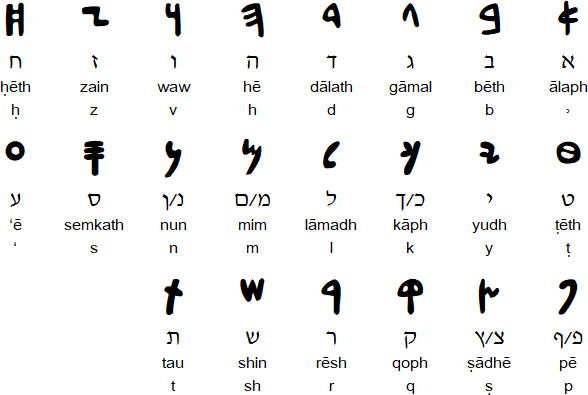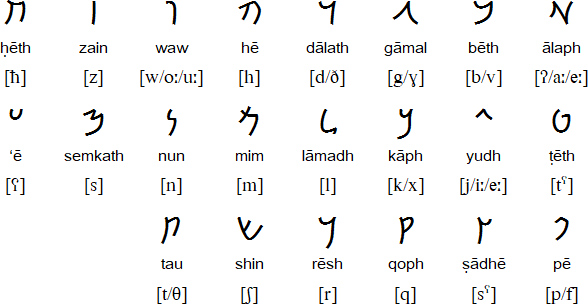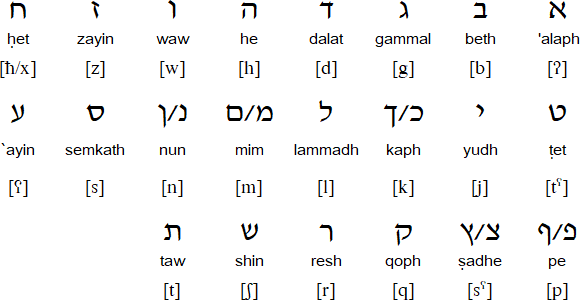Aramaic (ܐܪܡܝܐ, ארמית, Arāmît)
The Aramaic alphabet was adaptaed from the Phoenician alphabet during the 8th century BC and was used to write the Aramaic language until about 600 AD. The Aramaic alphabet was adapted to write quite a few other languages, and developed into a number of new alphabets, including the Hebrew square script and cursive script, Nabataean, Syriac, Palmyrenean, Mandaic, Sogdian, Mongolian and probably the Old Turkic script.Notable features
- Type of writing system: consonant alphabet (abjad)
- Direction of writing: right to left in horizontal lines
Used to write
Aramaic, a Semitic language which was the lingua franca of much of the Near East from about 7th century BC until the 7th century AD, when it was largely replaced by Arabic. Classical or Imperial Aramaic was the main language of the Persian, Babylonian and Assyrian empires and spread as far as Greece and the Indus valley.After Alexander the Great destroyed the Persian Empire, Aramaic ceased to be the official language of any major state, though continued to be spoken widely. It was during this period that Aramaic split into western and eastern dialects.
Aramaic was once the main language of the Jews and appears in some of the Dead Sea Scrolls. It is still used as a liturgical language by Christian communities in Syria, Lebanon and Iraq, and is spoken by small numbers of people in Iraq, Turkey, Iran, Armenia, Georgia and Syria.
Today Biblical Aramaic, Jewish Neo-Aramaic dialects and the Aramaic language of the Talmud are written in the Hebrew alphabet, while the Syriac alphabet is used to write Syriac and Christian Neo-Aramaic dialects, and the Mandaic alphabet is used for Mandaic.
Early Aramaic alphabet
The Early Aramaic alphabet was developed sometime during the late 10th or early 9th century BC and replaced Assyrian cuneiform as the main writing system of the Assyrian empire.
Imperial Aramaic alphabet
This version of the Aramaic alphabet dates from the 5th century BC and was used to write Imperial Aramaic, the standardised and offical language of the Archaemenid Empire. It was adapted to write Hebrew during the 5th century BC, and the modern version shown below is still used to write Neo-Aramaic dialects.
Square script for Aramaic

Downloads
Download Aramaic alphabet charts in Excel or PDF formatSample text in Aramaic (Isaric dialect)
Yàlidïn ìnon čol-ènašëya čwaþ χeḁrrëya we šàwyëya va ǧurča we va zìdqëya. Bìyìzvədun yal χuešaba we yal þeḁrþa, we koyìsˀərun χàd ləwaþ χàd va ruχa di àχuþa.A recording of this text by Yaqob bar-Karoza | Details of the Latinate (Aramaic) Script
Translation
All human beings are born free and equal in dignity and rights. They are endowed with reason and conscience and should act towards one another in a spirit of brotherhood.(Article 1 of the Universal Declaration of Human Rights)
Tower of Babel in Aramaic in the Square script
Links
Information about the Aramaic alphabet and languagehttp://www.nativlang.com/aramaic-language/aramaic-writing.php
http://en.wikipedia.org/wiki/Aramaic_alphabet
http://members.aol.com/assyrianme/aramaic/history.html
http://en.wikipedia.org/wiki/Aramaic_language
The Comprehensive Aramaic Lexicon and texts
http://cal1.cn.huc.edu/
Online Aramaic lessons
http://www.learnassyrian.com
http://wn.com/Modern_Aramaic
Learn Aramaic online
Free Aramaic fonts
http://www.historian.net/files.htm
http://www.aramaicpeshitta.com/fonts.htm
Aramaic Peshitta Bible Repository
http://www.aramaicpeshitta.com
Aramaic Designs - Aramaic Translations & Classes
http://www.AramaicDesigns.com









.jpg)
.jpg)

.jpg)





0 comments:
Post a Comment
Note: Only a member of this blog may post a comment.